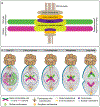Asymmetric Histone Inheritance: Establishment, Recognition, and Execution
- PMID: 35905975
- PMCID: PMC10054593
- DOI: 10.1146/annurev-genet-072920-125226
Asymmetric Histone Inheritance: Establishment, Recognition, and Execution
Abstract
The discovery of biased histone inheritance in asymmetrically dividing Drosophila melanogaster male germline stem cells demonstrates one means to produce two distinct daughter cells with identical genetic material. This inspired further studies in different systems, which revealed that this phenomenon may be a widespread mechanism to introduce cellular diversity. While the extent of asymmetric histone inheritance could vary among systems, this phenomenon is proposed to occur in three steps: first, establishment of histone asymmetry between sister chromatids during DNA replication; second, recognition of sister chromatids carrying asymmetric histone information during mitosis; and third, execution of this asymmetry in the resulting daughter cells. By compiling the current knowledge from diverse eukaryotic systems, this review comprehensively details and compares known chromatin factors, mitotic machinery components, and cell cycle regulators that may contribute to each of these three steps. Also discussed are potential mechanisms that introduce and regulate variable histone inheritance modes and how these different modes may contribute to cell fate decisions in multicellular organisms.
Keywords: DNA replication–coupled histone assembly; epigenetic inheritance; epigenetic memory; mitotic drive; nonrandom chromatid segregation; nucleosome density.
Conflict of interest statement
Figures






Similar articles
-
Mitotic drive in asymmetric epigenetic inheritance.Biochem Soc Trans. 2022 Apr 29;50(2):675-688. doi: 10.1042/BST20200267. Biochem Soc Trans. 2022. PMID: 35437581 Free PMC article.
-
Asymmetric Centromeres Differentially Coordinate with Mitotic Machinery to Ensure Biased Sister Chromatid Segregation in Germline Stem Cells.Cell Stem Cell. 2019 Nov 7;25(5):666-681.e5. doi: 10.1016/j.stem.2019.08.014. Epub 2019 Sep 26. Cell Stem Cell. 2019. PMID: 31564548 Free PMC article.
-
Asymmetric distribution of histones during Drosophila male germline stem cell asymmetric divisions.Chromosome Res. 2013 May;21(3):255-69. doi: 10.1007/s10577-013-9356-x. Chromosome Res. 2013. PMID: 23681658 Free PMC article. Review.
-
CENP-C functions in centromere assembly, the maintenance of CENP-A asymmetry and epigenetic age in Drosophila germline stem cells.PLoS Genet. 2021 May 20;17(5):e1009247. doi: 10.1371/journal.pgen.1009247. eCollection 2021 May. PLoS Genet. 2021. PMID: 34014920 Free PMC article.
-
Asymmetric Histone Inheritance in Asymmetrically Dividing Stem Cells.Trends Genet. 2020 Jan;36(1):30-43. doi: 10.1016/j.tig.2019.10.004. Epub 2019 Nov 18. Trends Genet. 2020. PMID: 31753528 Free PMC article. Review.
Cited by
-
Molecular mechanism of parental H3/H4 recycling at a replication fork.Nat Commun. 2024 Nov 2;15(1):9485. doi: 10.1038/s41467-024-53187-4. Nat Commun. 2024. PMID: 39488545 Free PMC article.
-
Helical coiled nucleosome chromosome architectures during cell cycle progression.Proc Natl Acad Sci U S A. 2024 Oct 22;121(43):e2410584121. doi: 10.1073/pnas.2410584121. Epub 2024 Oct 14. Proc Natl Acad Sci U S A. 2024. PMID: 39401359 Free PMC article.
-
Mitotic inheritance of genetic and epigenetic information via the histone H3.1 variant.Curr Opin Plant Biol. 2023 Oct;75:102401. doi: 10.1016/j.pbi.2023.102401. Epub 2023 Jun 9. Curr Opin Plant Biol. 2023. PMID: 37302254 Free PMC article. Review.
-
Modulating DNA Polα Enhances Cell Reprogramming Across Species.bioRxiv [Preprint]. 2024 Sep 20:2024.09.19.613993. doi: 10.1101/2024.09.19.613993. bioRxiv. 2024. PMID: 39345551 Free PMC article. Preprint.
-
The fork protection complex promotes parental histone recycling and epigenetic memory.Cell. 2024 Sep 5;187(18):5029-5047.e21. doi: 10.1016/j.cell.2024.07.017. Epub 2024 Aug 1. Cell. 2024. PMID: 39094569 Free PMC article.
References
Literature cited:
Publication types
MeSH terms
Substances
Grants and funding
LinkOut - more resources
Full Text Sources
Molecular Biology Databases

